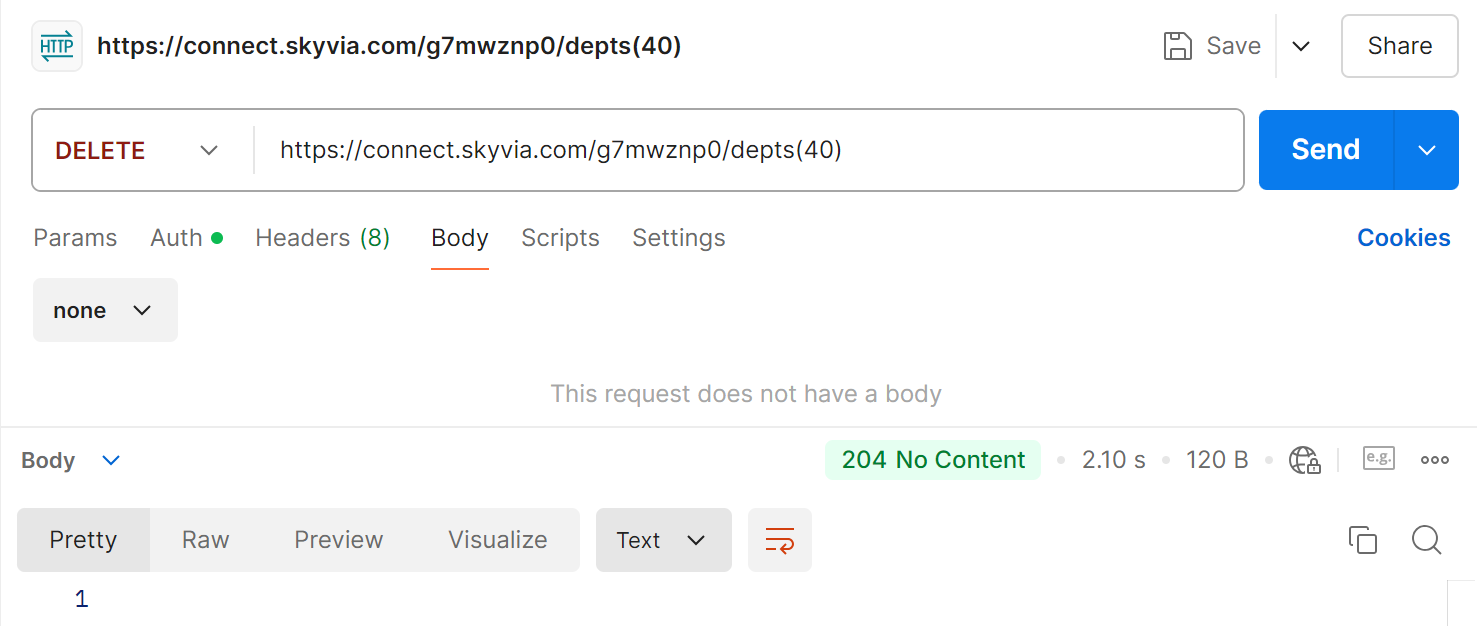Sending Requests to Skyvia Connect OData Endpoints
Here we provide basic examples on how you may interact with Skyvia Connect OData endpoints by sending requests via curl or Postman. For more information on OData protocol features that Skyvia Connect OData endpoints support, see Supported OData Protocol Features.
OData Protocol Versions
Skyvia Connect supports creating both OData v1 – v3 endpoints and OData v4 endpoints. You can select the default OData version, that is used when accessing the endpoint by its root URL, when you create or edit the endpoint.
However, actually, Skyvia makes the published data available via both protocol versions, by adding odata3/ or odata4/ to the endpoint URL:
https://endpoint.skyvia.com/********/
OData protocol version, specified in the endpoint editor is used.
https://endpoint.skyvia.com/********/odata3/
OData protocol v3 is used.
https://endpoint.skyvia.com/********/odata4/
OData protocol v4 is used.
When accessed via the OData v3 protocol, endpoints use ATOM format for sending and receiving data by default. They also support JSON format. You can switch to using the JSON format by using the $format Query Option. When accessed via the OData v4 protocol, endpoints use JSON format by default.
Sample Endpoint
In this examples, we will use an endpoint for an SQL Server database with the following table:
1
2
3
4
5
6
7
8
CREATE TABLE dept (
deptno INT PRIMARY KEY,
dname VARCHAR(14),
loc VARCHAR(13)
);
INSERT INTO dept (deptno, dname, loc) VALUES (10,'Accounting','New York');
INSERT INTO dept VALUES (20,'Sales','Dallas');
INSERT INTO dept VALUES (30,'Sales2','Chicago');
Authorization
If you have specified usernames and passwords for the endpoint, you need to use basic authentication. In Postman, you can configure it on the Authorization tab. In the Auth Type box, select Basic Auth, and then enter the endpoint Username and Password.
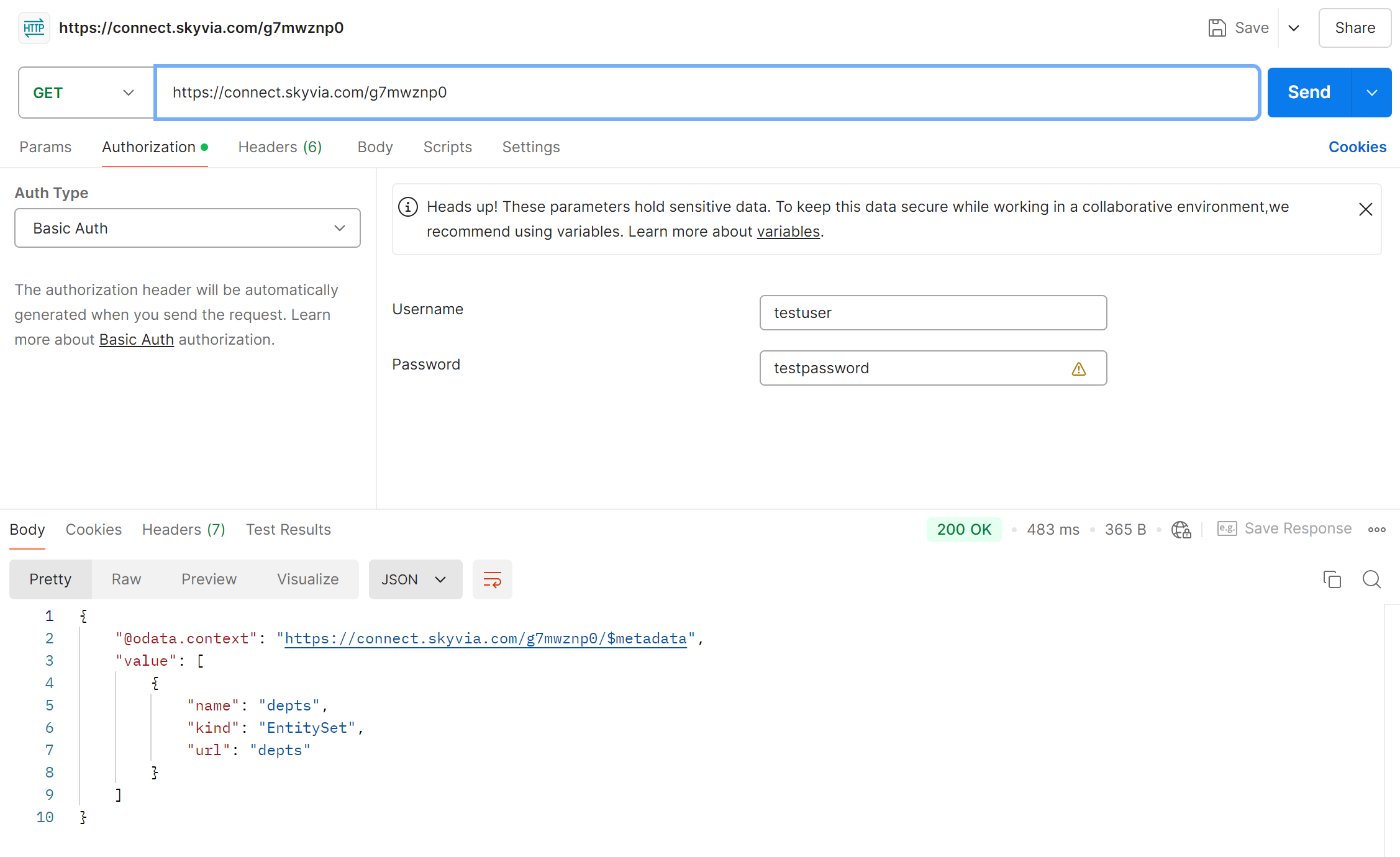
In curl, you use the -u parameter with value in the format "login:password", like this:
curl https://connect.skyvia.com/g7mwznp0 -u "testuser:testpassword"
Querying Data
To query data from an endpoint, you need to perform a GET request to an endpoint entity set. For example, for OData v4 protocol:
curl https://connect.skyvia.com/g7mwznp0/odata4/depts/ -u "testuser:testpassword"
The response is:
1
2
3
4
5
6
7
8
9
10
11
{
"@odata.context":"https://connect.skyvia.com/g7mwznp0/odata4/$metadata#depts","value":[
{
"deptno":10,"dname":"Accounting","loc":"New York"
},{
"deptno":20,"dname":"Sales","loc":"Dallas"
},{
"deptno":30,"dname":"Sales2","loc":"Chicago"
}
]
}
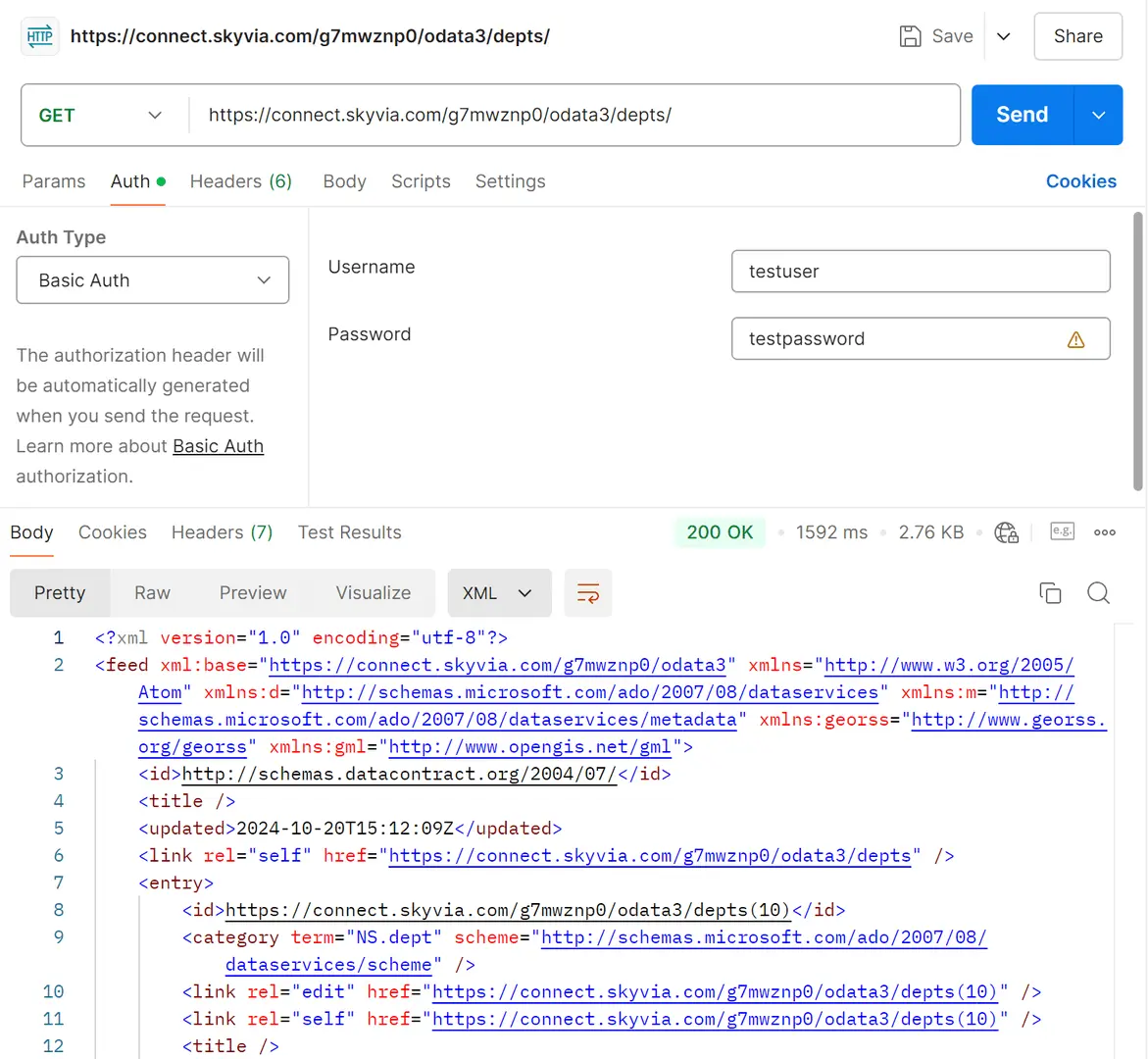
For OData v3 endpoint, the response is returned in the ATOM format.
curl https://connect.skyvia.com/g7mwznp0/odata3/depts/ -u "testuser:testpassword"
The response is:
1
2
3
4
5
6
7
8
9
10
11
12
13
14
15
16
17
18
19
20
21
22
23
24
25
26
27
28
29
30
31
32
33
34
35
36
37
38
39
40
41
42
43
44
45
46
47
48
49
50
51
52
53
54
55
56
57
58
59
60
61
<?xml version="1.0" encoding="utf-8"?>
<feed xml:base="https://connect.skyvia.com/g7mwznp0/odata3" xmlns="http://www.w3.org/2005/Atom" xmlns:d="http://schemas.microsoft.com/ado/2007/08/dataservices" xmlns:m="http://schemas.microsoft.com/ado/2007/08/dataservices/metadata" xmlns:georss="http://www.georss.org/georss" xmlns:gml="http://www.opengis.net/gml">
<id>http://schemas.datacontract.org/2004/07/</id>
<title />
<updated>2024-10-20T14:23:27Z</updated>
<link rel="self" href="https://connect.skyvia.com/g7mwznp0/odata3/depts" />
<entry>
<id>https://connect.skyvia.com/g7mwznp0/odata3/depts(10)</id>
<category term="NS.dept" scheme="http://schemas.microsoft.com/ado/2007/08/dataservices/scheme" />
<link rel="edit" href="https://connect.skyvia.com/g7mwznp0/odata3/depts(10)" />
<link rel="self" href="https://connect.skyvia.com/g7mwznp0/odata3/depts(10)" />
<title />
<updated>2024-10-20T14:23:27Z</updated>
<author>
<name />
</author>
<content type="application/xml">
<m:properties>
<d:deptno m:type="Edm.Int32">10</d:deptno>
<d:dname>Accounting</d:dname>
<d:loc>New York</d:loc>
</m:properties>
</content>
</entry>
<entry>
<id>https://connect.skyvia.com/g7mwznp0/odata3/depts(20)</id>
<category term="NS.dept" scheme="http://schemas.microsoft.com/ado/2007/08/dataservices/scheme" />
<link rel="edit" href="https://connect.skyvia.com/g7mwznp0/odata3/depts(20)" />
<link rel="self" href="https://connect.skyvia.com/g7mwznp0/odata3/depts(20)" />
<title />
<updated>2024-10-20T14:23:27Z</updated>
<author>
<name />
</author>
<content type="application/xml">
<m:properties>
<d:deptno m:type="Edm.Int32">20</d:deptno>
<d:dname>Sales</d:dname>
<d:loc>Dallas</d:loc>
</m:properties>
</content>
</entry>
<entry>
<id>https://connect.skyvia.com/g7mwznp0/odata3/depts(30)</id>
<category term="NS.dept" scheme="http://schemas.microsoft.com/ado/2007/08/dataservices/scheme" />
<link rel="edit" href="https://connect.skyvia.com/g7mwznp0/odata3/depts(30)" />
<link rel="self" href="https://connect.skyvia.com/g7mwznp0/odata3/depts(30)" />
<title />
<updated>2024-10-20T14:23:27Z</updated>
<author>
<name />
</author>
<content type="application/xml">
<m:properties>
<d:deptno m:type="Edm.Int32">30</d:deptno>
<d:dname>Sales2</d:dname>
<d:loc>Chicago</d:loc>
</m:properties>
</content>
</entry>
</feed>
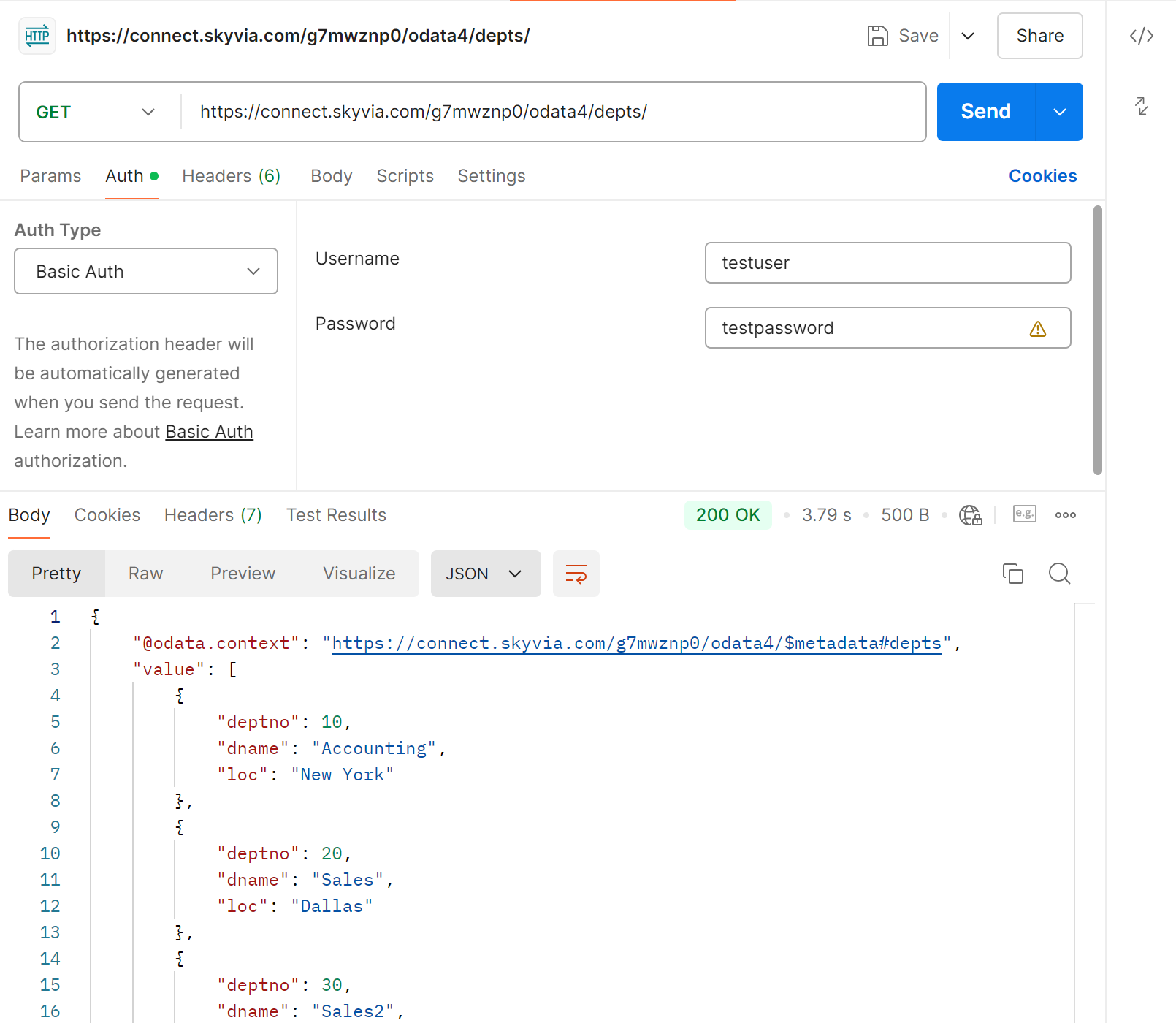
Inserting Data
To create a new record via OData, you need to perform the POST request to the respective entity set URL.
For OData v4 protocol, use the following request:
1
2
3
4
5
6
7
8
9
10
curl 'https://connect.skyvia.com/g7mwznp0/odata4/depts/' \
-u 'testuser:testpassword' \
--header 'Content-Type: application/json' \
--header 'Authorization: ••••••' \
--data '
{
"deptno": 40,
"dname": "Development",
"loc": "Los Angeles"
}'
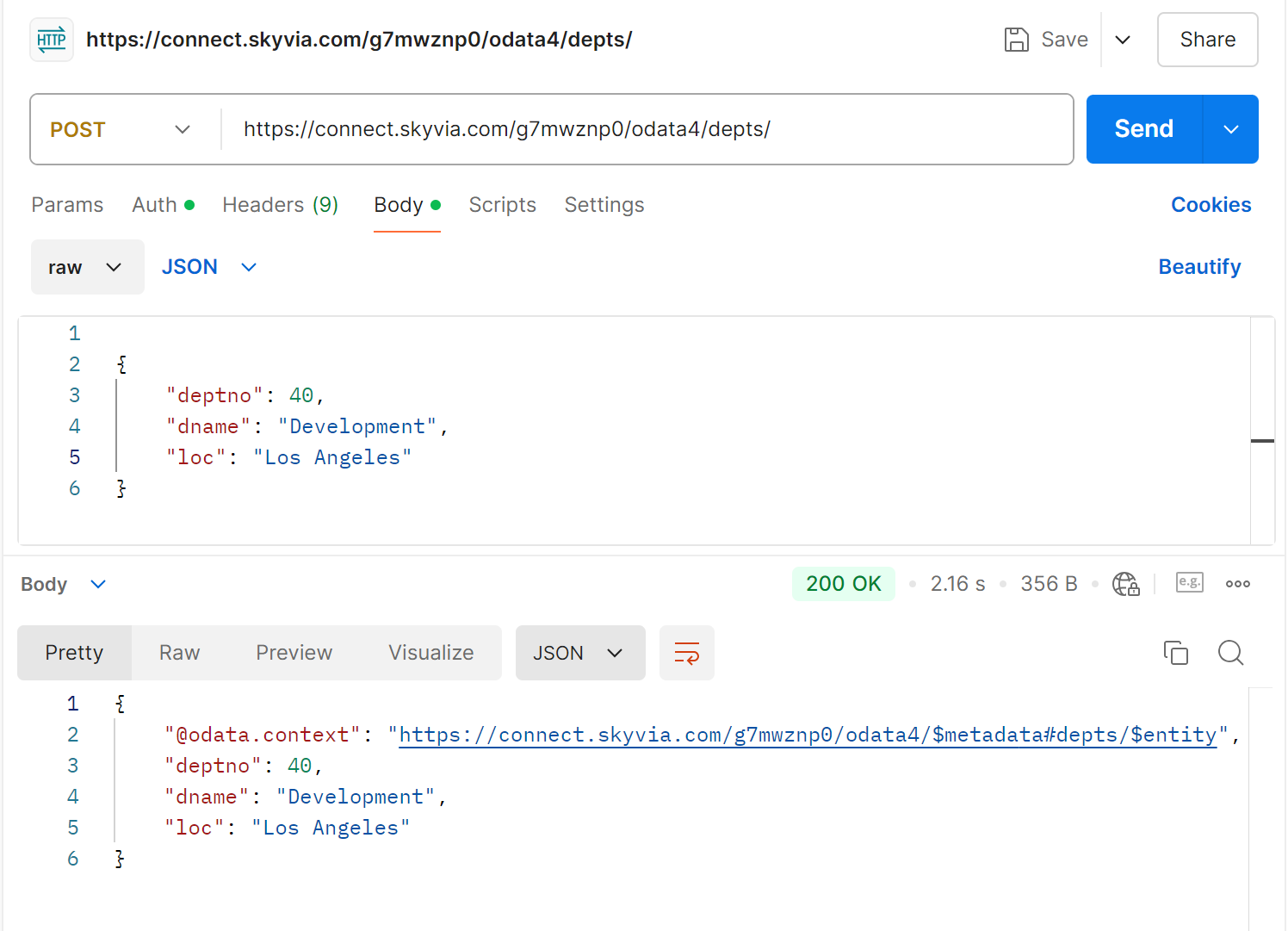
Note that you may need to explicitly add Content-Type header with the application/json value.
The response is:
1
2
3
4
5
6
{
"@odata.context": "https://connect.skyvia.com/g7mwznp0/odata4/$metadata#depts/$entity",
"deptno": 40,
"dname": "Development",
"loc": "Los Angeles"
}
For OData v3 protocol, use the following request:
1
2
3
4
5
6
7
8
9
10
11
12
13
14
15
curl -X POST 'https://connect.skyvia.com/g7mwznp0/odata3/depts/' \
-u "testuser:testpassword" \
--header 'Content-Type: application/atom+xml' \
--data-raw '<?xml version="1.0" encoding="utf-8" standalone="yes"?>
<atom:entry xmlns:atom="http://www.w3.org/2005/Atom"
xmlns:m="http://schemas.microsoft.com/ado/2007/08/dataservices/metadata"
xmlns:d="http://schemas.microsoft.com/ado/2007/08/dataservices">
<atom:content type="application/xml">
<m:properties>
<d:deptno m:type="Edm.Int32">40</d:deptno>
<d:dname>Development</d:dname>
<d:loc>Los Angeles</d:loc>
</m:properties>
</atom:content>
</atom:entry>'
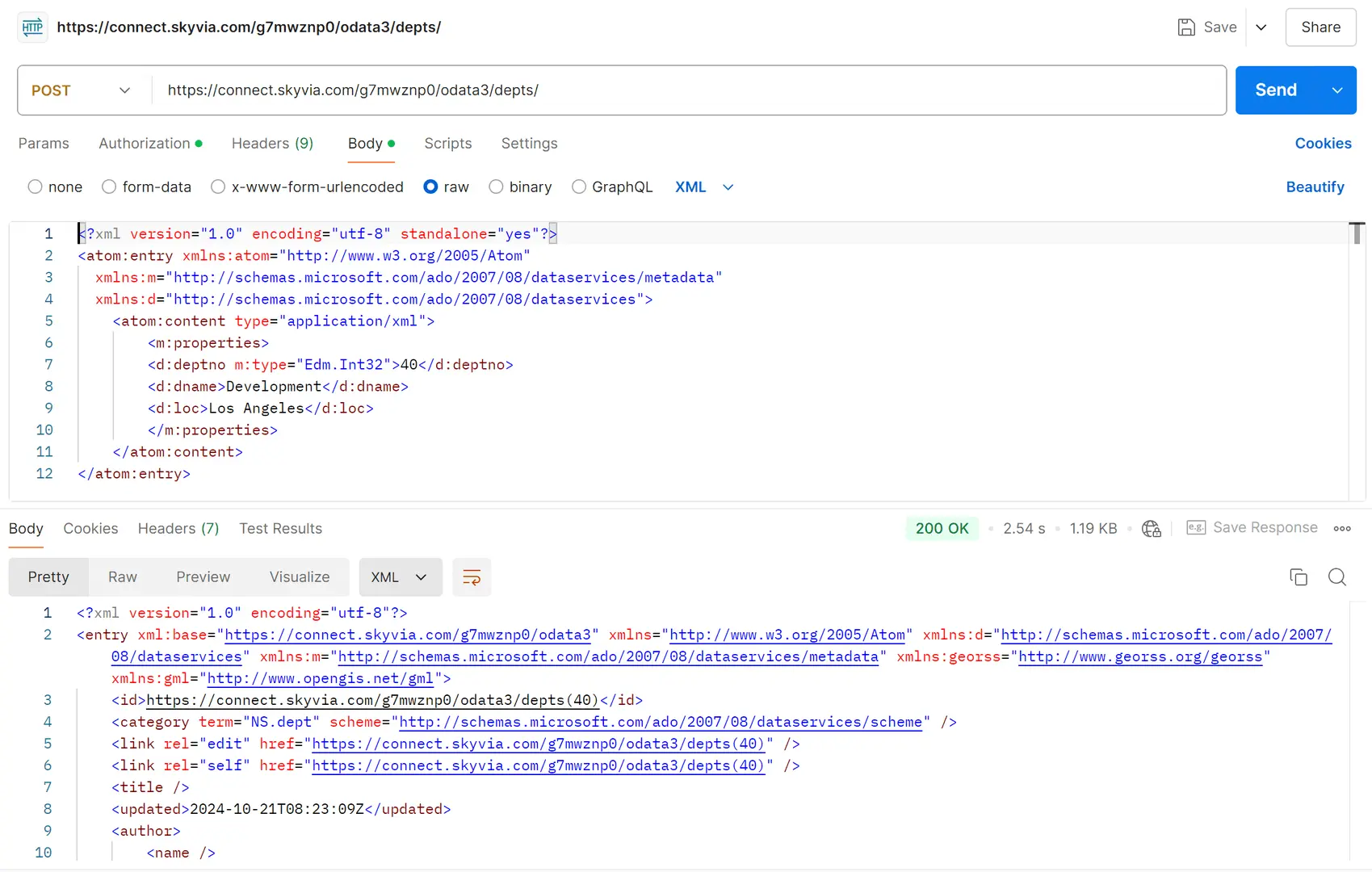
Don't forget to specify a custom Content-Type header in Postman with the value application/atom+xml.
The response is:
1
2
3
4
5
6
7
8
9
10
11
12
13
14
15
16
17
18
19
<?xml version="1.0" encoding="utf-8"?>
<entry xml:base="https://connect.skyvia.com/g7mwznp0/odata3" xmlns="http://www.w3.org/2005/Atom" xmlns:d="http://schemas.microsoft.com/ado/2007/08/dataservices" xmlns:m="http://schemas.microsoft.com/ado/2007/08/dataservices/metadata" xmlns:georss="http://www.georss.org/georss" xmlns:gml="http://www.opengis.net/gml">
<id>https://connect.skyvia.com/g7mwznp0/odata3/depts(40)</id>
<category term="NS.dept" scheme="http://schemas.microsoft.com/ado/2007/08/dataservices/scheme" />
<link rel="edit" href="https://connect.skyvia.com/g7mwznp0/odata3/depts(40)" />
<link rel="self" href="https://connect.skyvia.com/g7mwznp0/odata3/depts(40)" />
<title />
<updated>2024-10-23T08:07:16Z</updated>
<author>
<name />
</author>
<content type="application/xml">
<m:properties>
<d:deptno m:type="Edm.Int32">40</d:deptno>
<d:dname>Development</d:dname>
<d:loc>Los Angeles</d:loc>
</m:properties>
</content>
</entry>
Updating Data
OData provides different ways to update entity data via OData. You can use PUT requests to completely replace entity data, but you must specify all its properties that are not of default values. Alternatively, you can perform PATCH requests with only the properties you want to update.
Let's update the location of the new department to 'Miami' in these two ways
PUT Request
OData v4 Protocol
Here is how you perform the request via OData v4 protocol.
1
2
3
4
5
6
7
8
curl -X PUT 'https://connect.skyvia.com/g7mwznp0/odata3/depts(40)' \
-u "testuser:testpassword" \
--header 'Content-Type: application/json' \
--data-raw '{
"deptno": 40,
"dname": "Development",
"loc": "Miami"
}'
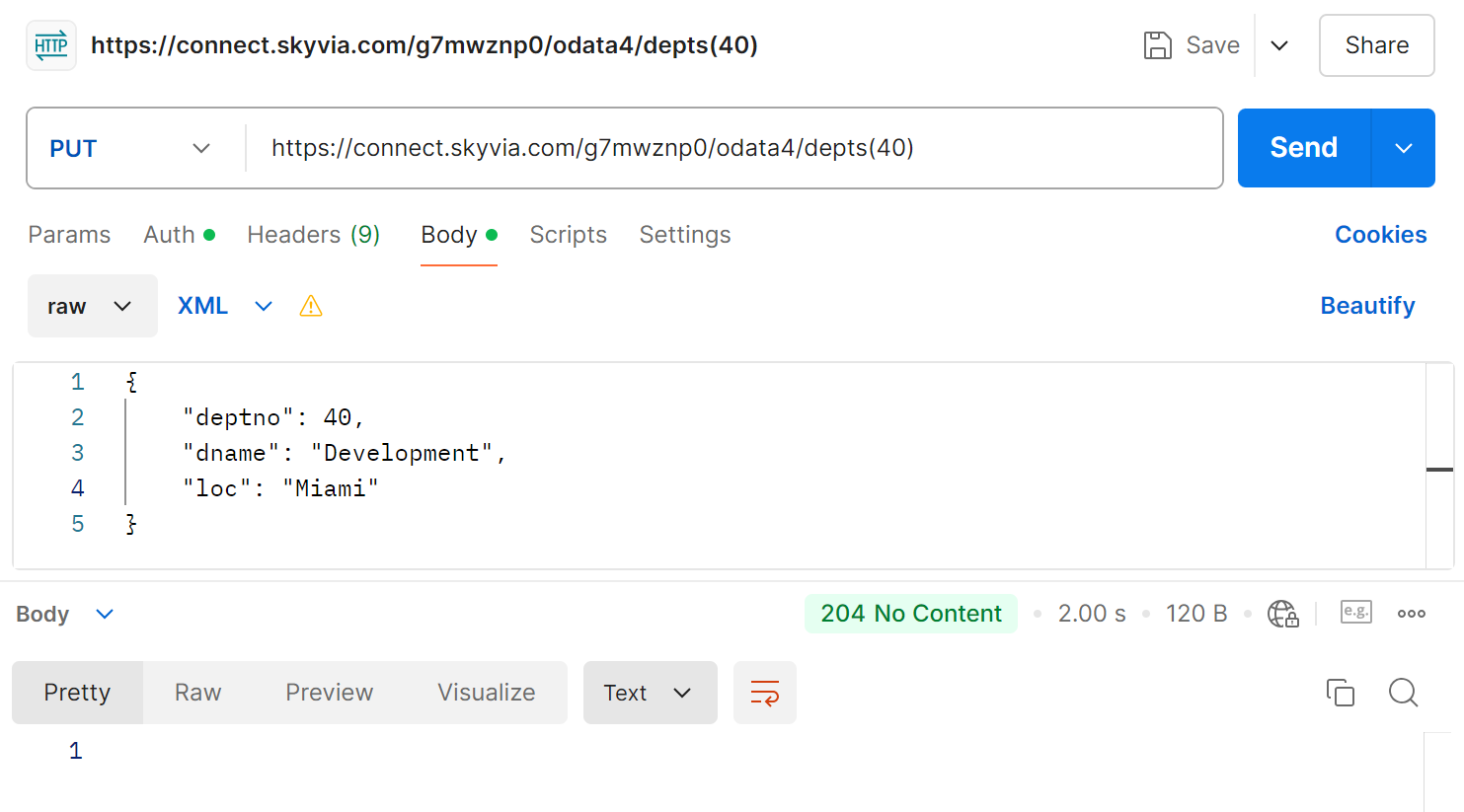
As the result, you get the 204 No Content response, and the record is updated in the data source.
OData v3 Protocol
Here is how you perform the request via OData v3 protocol.
1
2
3
4
5
6
7
8
9
10
11
12
13
14
15
16
17
18
19
20
21
22
23
24
25
26
curl -X PUT 'https://connect.skyvia.com/g7mwznp0/odata3/depts(40)' \
-u "testuser:testpassword" \
--header 'Content-Type: application/atom+xml' \
--data-raw '<?xml version="1.0" encoding="utf-8"?>
<entry xml:base="https://connect.skyvia.com/g7mwznp0/odata3"
xmlns="http://www.w3.org/2005/Atom"
xmlns:d="http://schemas.microsoft.com/ado/2007/08/dataservices"
xmlns:m="http://schemas.microsoft.com/ado/2007/08/dataservices/metadata"
xmlns:georss="http://www.georss.org/georss"
xmlns:gml="http://www.opengis.net/gml">
<id>https://connect.skyvia.com/g7mwznp0/odata3/depts(40)</id>
<category term="NS.dept" scheme="http://schemas.microsoft.com/ado/2007/08/dataservices/scheme" />
<link rel="edit" href="https://connect.skyvia.com/g7mwznp0/odata3/depts(40)" />
<link rel="self" href="https://connect.skyvia.com/g7mwznp0/odata3/depts(40)" />
<title />
<author>
<name />
</author>
<content type="application/xml">
<m:properties>
<d:deptno m:type="Edm.Int32">40</d:deptno>
<d:dname>Development</d:dname>
<d:loc>Miami</d:loc>
</m:properties>
</content>
</entry>'
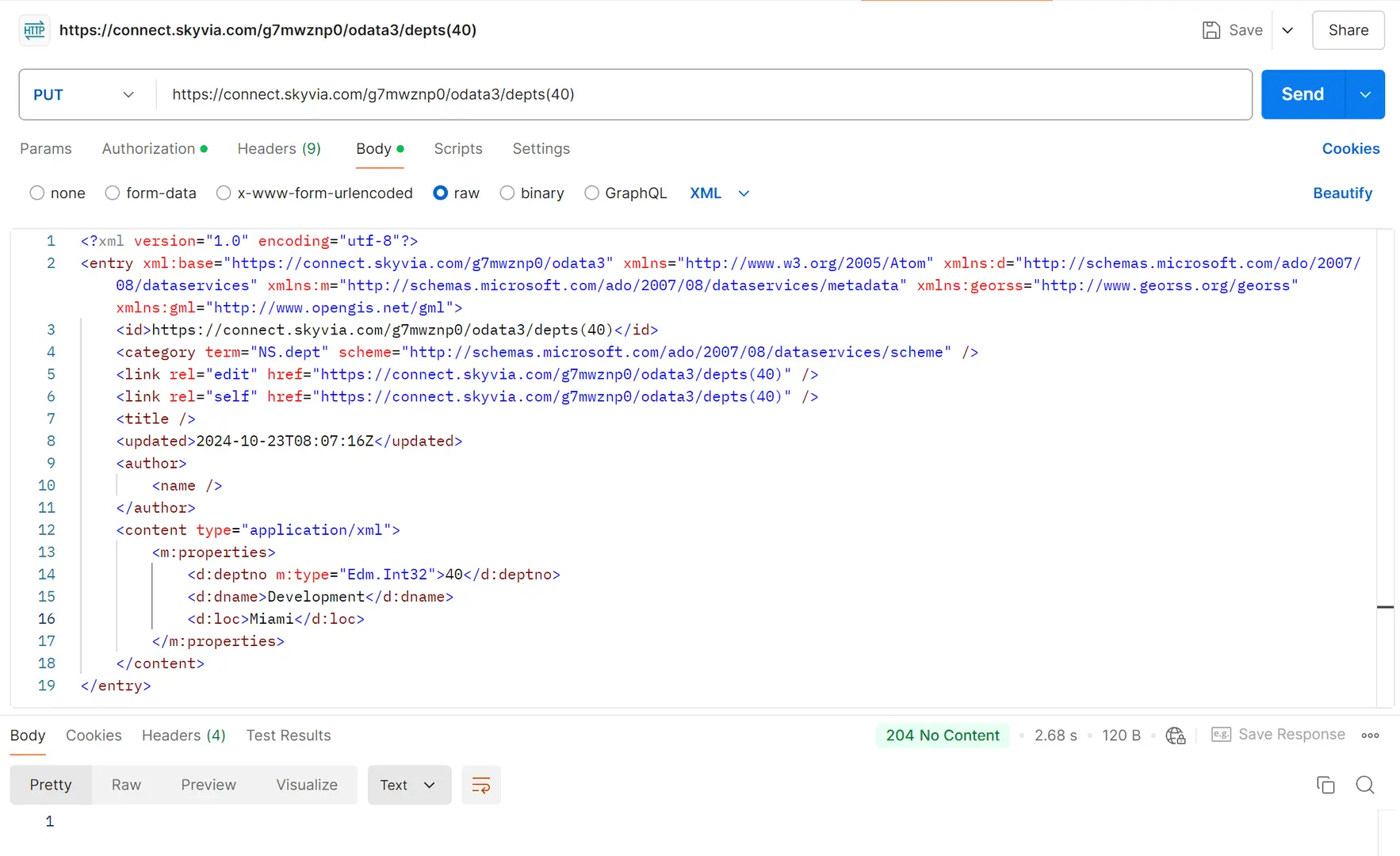
PATCH Request
With the patch request, you can update values for one or more entity properties.
OData v4 Protocol
Here is how you perform the request via OData v4 protocol.
1
2
3
4
5
6
curl -X PATCH 'https://connect.skyvia.com/g7mwznp0/odata3/depts(40)' \
-u "testuser:testpassword" \
--header 'Content-Type: application/json' \
--data-raw '{
"loc": "Miami"
}'
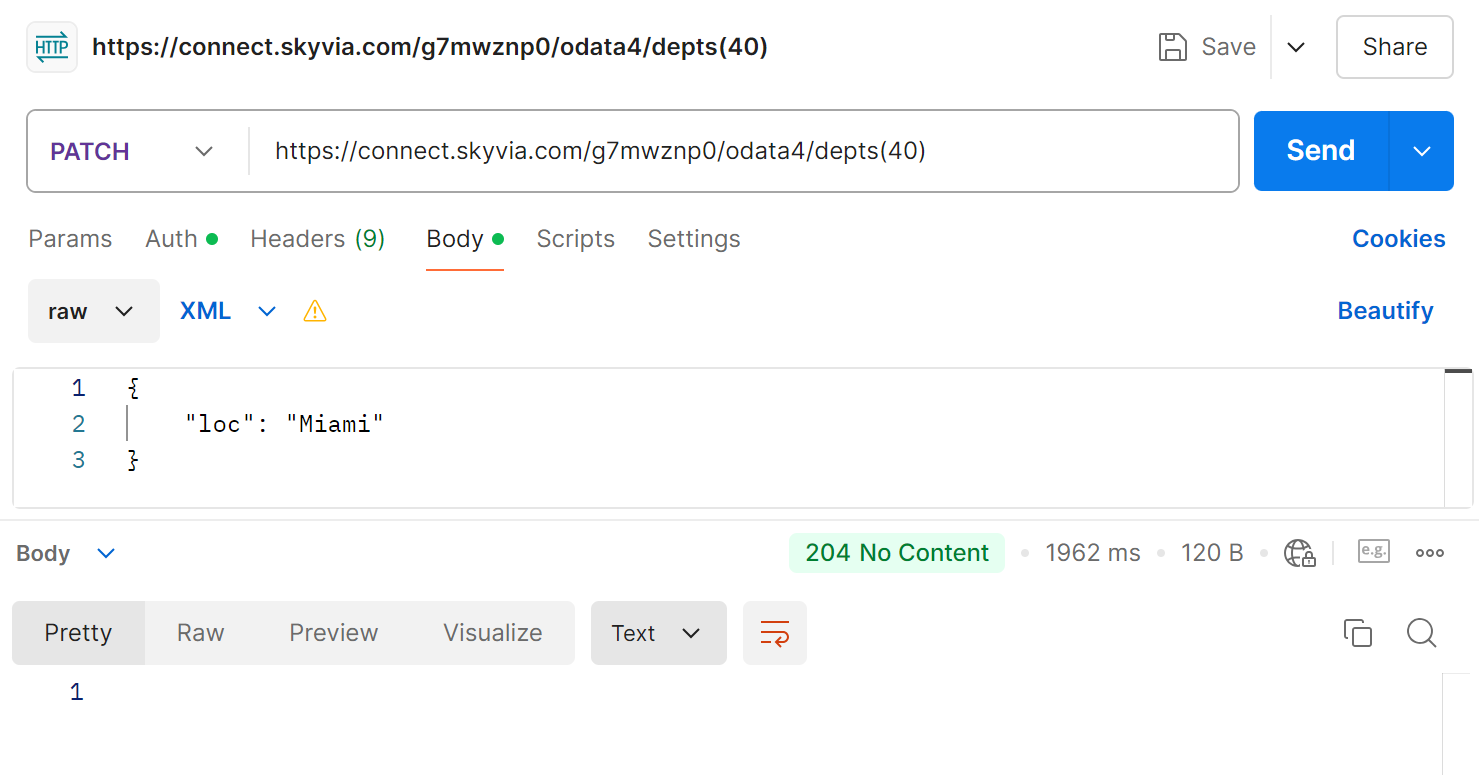
As the result, you get the 204 No Content response, and the record is updated in the data source.
OData v3 Protocol
Here is how you perform the request via OData v3 protocol.
1
2
3
4
5
6
7
8
9
10
11
12
13
14
15
16
17
18
19
20
21
22
curl -X PUT 'https://connect.skyvia.com/g7mwznp0/odata3/depts(40)' \
-u "testuser:testpassword" \
--header 'Content-Type: application/atom+xml' \
--data-raw '<?xml version="1.0" encoding="utf-8"?>
<entry xml:base="https://connect.skyvia.com/g7mwznp0/odata3"
xmlns="http://www.w3.org/2005/Atom"
xmlns:d="http://schemas.microsoft.com/ado/2007/08/dataservices"
xmlns:m="http://schemas.microsoft.com/ado/2007/08/dataservices/metadata"
xmlns:georss="http://www.georss.org/georss"
xmlns:gml="http://www.opengis.net/gml">
<id>https://connect.skyvia.com/g7mwznp0/odata3/depts(40)</id>
<category term="NS.dept" scheme="http://schemas.microsoft.com/ado/2007/08/dataservices/scheme" />
<title />
<author>
<name />
</author>
<content type="application/xml">
<m:properties>
<d:loc>Miami</d:loc>
</m:properties>
</content>
</entry>'

Deleting Data
You can delete an OData entity by performing the DELETE request to the URL of this entity, regardless of the protocol version used.
curl -X DELETE https://connect.skyvia.com/g7mwznp0/depts(40) -u "testuser:testpassword"
